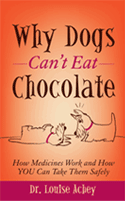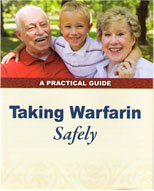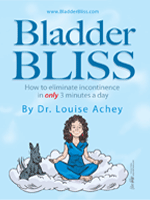Eating Green Veggies When Taking Warfarin
It’s the LEECH I Can Do For You
I was reading an old article I saved from the newspaper about leeches used to treat medical conditions. It described a leech farm in Russia called the International Medical Leech Center in Moscow, which supplies leeches to medical clinics in Russia and nearby countries.
It brought back memories of my years as a hospital pharmacist with a very specialized responsibility: leech disposal.
My experience as a Leech Disposal Specialist began in 1987 in a 600-bed hospital in Dayton, Ohio. Our pharmacy manager started our staff meeting one Wednesday morning by clearing his throat. “We have a special request from nursing. The plastic surgeons are using medical leeches occasionally on some of their post-surgical cases. After being applied to the affected area, the leeches feed for several hours, are removed and new ones applied until the surgeon discontinues the treatment. After removing the leeches, the nurses want someone from pharmacy to come and take them away for disposal.”
“Eew!” was clearly on my face as well as my fellow pharmacists. Dead silence stretched on and on and on. About a year later, I raised my hand, hearing myself saying, “I’ll do it. When the nurses call, I’ll go and take the used leeches away.”
My next step was to learn more about these small creatures that could make the difference between a successful reattachment and permanent disfigurement. Plastic surgeons in the United States performing microsurgery had just started using medical leeches in cases of last resort when reattaching skin flaps or appendages such as fingers, ears and noses. In those cases, the tiny repaired arteries worked just fine at bringing in vital fresh blood into the reattached nose or finger but the even tinier veins had clotted off, blocking them from carrying fresh blood away from the surgical area.
The result was swelling that would doom the success of the reattachment if it wasn’t relieved. I saw the miraculous difference that medical leeches made in these patients. The application of a leech opened up the clotted veins and “bled off” the excess blood that had accumulated, giving the body time to heal itself.
Our surgeons ordered the leeches directly from a company in South Wales called Biopharm Leech, which has farmed leeches for medical use since 1812. They raise these small worms with teeth in clean, carefully controlled conditions and ship them by air, arriving ready to apply immediately. Today, Biopharm uses Carolina Medical Supply as their US distributer, and you order your medical leeches directly from them.
Medical leeches arrive “hungry”, so they’re ready to use immediately. When applied, they attach 300 tiny “teeth” into the area, and the miracle starts. Leeches are living factories of pharmaceutical magic: leech saliva contains several amazing chemicals, including a clot-busting agent, a long-acting anticoagulant and an anesthetic.
Once a leech attaches, they secrete a clot-busting agent called hirudin, which goes to work to dissolve the clots blocking blood flow through the veins. At the same time, their anticoagulant ensures they can continue to feed without clots forming in the immediate area and the anesthetic makes the process practically painless. As they feed, they draw out from 15 to 30ml of blood each, nearly one ounce per leech. After removal, the leech anticoagulant continues to encourage bleeding for up to 10-12 hours, further relieving congestion from excess blood collecting in the reattached tissue.
Once a leech is “full”, and has either dropped off or been removed, what do you do with it? Ah, that was MY job. The nurses called me and I arrived to take away the “used” leeches. The recommended disposal process at that time was to put them into a 70% alcohol solution to immobilize them, and then flush them into the sewer system. So I carried them back to the pharmacy, drained out the water from their container, poured 70% rubbing alcohol over them and then flushed them down the toilet. Biopharm now sells a leech disposal kit on their web site, www.Biopharm-leeches.com.
In 2004, the FDA approved the commercial marketing of hirudo medicinalis (leeches) for medical use, and today some hospital pharmacies actually store “fresh” leeches in their refrigerators. More information about medical leeches is available at the Biopharm website www.biopharm-leeches.com, which has the motto, “The Biting Edge of Science.”
Sunshine and Your Medicine
Tags: photosensitivity
The Invisible Line
Tags: accidental overdose, fatal overdose, opioids, oxycodone, Oxycontin, prescription drug overdose
For the past 4 years, John, a patient of mine has been living with liver tumors that cause him uncomfortable episodes of flushing and nausea several times a day and often in the middle of the night. After trying several different types of medicine, he found good results with oxycodone, a potent pain medicine.
John takes one long-acting oxycodone tablet called Oxycontin® twice a day but if that’s not enough to tame his flushing episodes he takes two additional tablets of short-acting oxycodone. He’s been taking a combination of long and short acting oxycodone for nearly 3 and a half years and it has worked pretty well for him. But since he’s been slowly increasing the amount of oxycodone he takes to control his episodes of flushing, he needed to know about The Invisible Line.
As we sat down together one afternoon last week, he started the conversation. “I try to keep what I take as little as possible, but sometimes I wake up at night with flushing and have to take an oxycodone in order to get back to sleep. I’m not abusing it; I only take it when I really need it.”
“I agree, John. But oxycodone is a very potent pain medicine, even if you aren’t using it specifically for pain. Oxycodone, hydrocodone, methadone or morphine, all of these can do the same thing to you: if you get enough of any of them in your system, you’ll STOP BREATHING.”
I added, “I really think there should be some kind of warning sign for these medicines, telling you that you were getting close to danger, like when paddling a canoe down a river you hear a roaring sound getting louder and louder, warning you that up ahead is a waterfall.”
“What if there no warning whatsoever that a waterfall lurked ahead? It was right there but you couldn’t hear it or see it until you were swept right over the edge. That river would be very dangerous to anyone heading downstream, wouldn’t it?”
“We don’t
Comments Off on The Invisible Line
How To Remove Ear Wax Easily
Tags: docusate, ear care, earwax, earwax removal
A Surprising Solution for Dry, Chapped Skin
Tags: Bag Balm®, chapped skin, Crisco, Eucerin, lanolin, petroleum jelly
Do You Need Vitamin E?
Tags: fat-soluble vitamins, Vitamin E
Q: How much Vitamin E should I take? Is natural Vitamin E any better than synthetic?
Vitamin E is a fat soluble vitamin that works as an antioxidant. An antioxidant helps protect your cells from damage by compounds called free radicals, which are produced by your body during metabolism. It was hoped that Vitamin E’s antioxidant action could decrease the risk of developing cancer, cataracts, heart disease and stroke, but in carefully designed clinical studies Vitamin E supplementation did not provide any benefit. In fact, Vitamin E supplementation was instead associated with an increased possibility of death, hemorrhagic stroke (stroke caused by bleeding into the brain) and prostate cancer.
How much Vitamin E do you need? According to the National Institutes for Health (the NIH), the recommended intake of Vitamin E for adults is 22.5 International Units (IU) daily. Although most Americans get about half that amount from their diet, Vitamin E deficiency is not very common. Vitamin E needs fat for it to be well absorbed, so eating a very low fat diet or having a disease that interferes with digestion or absorption of fat such as Crohn’s disease or cystic fibrosis can increase your risk of becoming deficient. Vitamin E deficiency may cause nerve and muscle damage with numbness in the arms and legs, muscle weakness, and vision problems. Vitamin E deficiency can also interfere with the effectiveness of your immune system.
Should you take a Vitamin E supplement? If most Americans get less than the recommended daily amount of Vitamin E in their diet, would taking it as a supplement make sense?
Most multivitamins include 30 IU of Vitamin E as alpha-tocopherol, which is considered 100% of the daily requirement for adults by the NIH. High dose Vitamin E supplements of 400 IU contain over 13 times that amount. The most common forms of Vitamin E are alpha-tocopherol and gamma-tocopherol. Gamma-tocopherol is found in foods rich in Vitamin E, with nuts, seeds, oils and green leafy vegetables such as spinach and broccoli the best sources.
Vitamin E as alpha-tocopherol exists in higher concentrations in the body than its cousin gamma-tocopherol, and until recently was assumed to be responsible for Vitamin E’s antioxidant effects. That may not be the whole story. Recent research has uncovered evidence that the key to the antioxidant potency of Vitamin E is the level of gamma-tocopherol, not the amount of alpha-tocopherol in the tissues and blood. Taking a supplement of alpha-tocopherol will actually decrease the level of gamma-tocopherol and suppress Vitamin E’s beneficial antioxidant action. This may explain why alpha-tocopherol supplements have produced negative instead of positive results in controlled research studies.
One study that found high dose Vitamin E supplementation to be helpful was the Age-Related Eye Disease Study, or AREDS. A formula of 5 vitamins and minerals including Vitamin E 400 IU was used in the 5 year study. In the most severely affected study participants, the AREDS formulation of Vitamins A, C and E combined with zinc and copper showed a 25% decrease in the progression of age-related macular degeneration (AMD), a common cause of blindness in the elderly. Those with mild or no AMD did not notice any benefit, however.
Most Vitamin E supplements contain alpha-tocopherol as either the natural form (d-alpha-tocopherol) or synthetic form (dl-alpha tocopherol). The main difference between them is their potency. The natural (d-alpha-tocopherol) form is 1.5 times as potent as the synthetic (dl- alpha-tocopherol) form. Gamma-tocopherol Vitamin E supplements are now available but it’s too early to know if they can prevent cancers, stroke or heart disease where the alpha-tocopherol form could not.
Unless you have age-related macular degeneration, taking a specific Vitamin E supplement is not only unnecessary but can cause bleeding problems, especially if you already take a blood thinner like warfarin, aspirin, or clopidogrel (Plavix®). For More information about Vitamin E is available at http://ods.od.nih.gov/factsheets/VitaminE-QuickFacts.
What’s In Bag Balm®
Tags: Bag Balm®, lanolin, petrolatum, petroleum jelly



